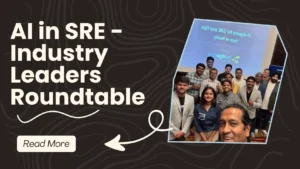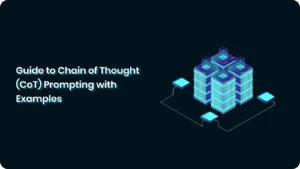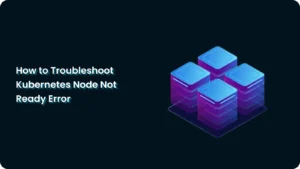AI Agent Workflows: Automation and Implementation Guide
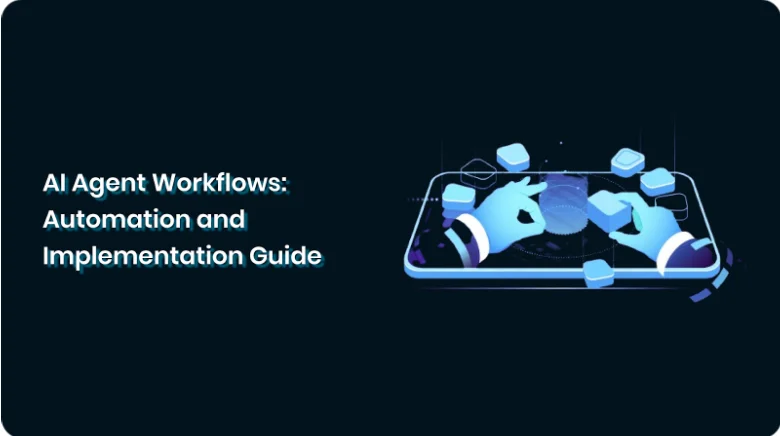
Enhance business efficiency with AI agent workflows. Explore task decomposition, workflow integration, and optimization benefits.
Imagine running a business where routine tasks handle themselves, decisions are made in real time, and customer issues are resolved instantly — without adding headcount or burning out your team. That’s what AI agent workflows make possible.
Unlike traditional automation tools that follow fixed scripts, AI agents are dynamic and intelligent. They interpret information, adapt to changing contexts, and act based on real-time data. These agents don’t just automate tasks — they manage entire workflows, learning and optimizing as they go.
For forward-thinking organizations, this means more than just saving time. It means unlocking faster execution, reducing human error, and freeing teams to focus on higher-impact, creative work. Whether you’re improving customer service, accelerating operations, or optimizing decision-making, AI agent workflows are the modern infrastructure for scaling efficiently and intelligently.
This guide walks you through everything you need to know — from how AI agent workflows function to how they’re implemented and their measurable impact across industries. Whether you’re just starting or ready to scale, you’ll find insights and strategies to make AI agents a meaningful part of your business transformation.
What are AI Agent Workflows?
AI agent workflows are end-to-end systems powered by intelligent agents that can handle tasks autonomously — from start to finish. But they’re more than just bots running scripts. These agents understand context, make decisions, and continuously improve with experience.
At its core, an AI agent workflow is a digital assembly line where software agents take on responsibility for actions that would otherwise require human involvement. They analyze data, make choices based on goals, and take the next best action—all within a structured, repeatable flow.
Think of it as upgrading from a rule-based system to a self-optimizing assistant. While traditional automation requires strict instructions, AI agents can adapt to changing information, learn from patterns, and operate with autonomy that mirrors human decision-making — but at machine speed and scale.
For example, instead of a human manually triaging customer support tickets, an AI agent can analyze the request, determine priority, suggest or execute a resolution, and even follow up — all without waiting for human intervention. The result? Faster outcomes, better consistency, and scalable service.
In short, AI agent workflows are not just about automation — they’re about augmentation. They elevate how businesses operate by integrating intelligence directly into everyday processes.
How AI Agents Improve Automation: Benefits
AI agents are redefining what automation can do. While traditional automation systems follow pre-coded rules, AI agents bring intelligence, adaptability, and decision-making power to the table — making your workflows smarter, faster, and more resilient.
Here’s how they raise the bar:
- Breaking Down Complex Tasks: AI agents excel at task decomposition. They can take large, complex processes and break them into smaller, manageable steps, speeding up execution and making inefficiencies easier to spot. For example, an AI agent can handle ID verification, system access, document submission, and training modules in employee onboarding without human intervention.
- Smarter Real-Time Decisions: Unlike static automation scripts, AI agents continuously evaluate data and make decisions based on context. In supply chain operations, for example, an AI agent might reroute deliveries due to weather or traffic disruptions without waiting for a manager’s input.
- Learning and Evolving: AI agents don’t just automate—they improve over time. They collect feedback with each interaction and refine their processes. For instance, a customer support agent can learn which responses yield higher satisfaction scores and adjust its messaging accordingly.
- Improved Efficiency and Productivity: By automating repetitive tasks, AI agents free up your team to focus on more strategic activities, boosting overall productivity.
- Autonomous, Data-Driven Decisions: AI agents allow for autonomous decision-making, reducing delays and improving efficiency, especially in high-volume operations.
- Scalability: AI agents scale effortlessly with your business, handling everything from a small team to millions of transactions without compromising quality or service.
Applications of AI Agent Workflows
AI agent workflows are no longer futuristic concepts — they’re already transforming how businesses operate across departments and industries. Wherever there’s repetitive work, complex decision-making, or the need for fast, scalable execution, AI agents are stepping in.
Here are a few key areas where they’re making a measurable difference:
- Customer Support That Doesn’t Sleep: AI chatbots and virtual agents manage millions of support interactions daily. They answer FAQs, troubleshoot issues, escalate only when necessary, and even personalize responses based on customer history. Outcome: Faster resolutions, lower support costs, and improved customer satisfaction without adding headcount.
- Smarter Business Operations: From automating scheduling and processing documents to handling routine approvals, AI agents streamline internal workflows. They ensure tasks are completed consistently and on time, reducing team friction. Outcome: Operations become leaner and more predictable, freeing staff to focus on strategic initiatives.
- Data-Driven Decision-Making: AI agents can scan massive datasets, extract insights, and act based on patterns humans might miss. They help leaders make faster, more informed decisions — often in real time. Outcome: More agile and confident decision-making rooted in data, not guesswork.
AI agent workflows are already transforming businesses in various ways. To better understand how these agents work, let’s explore the different types of AI agents that help drive these improvements across workflows.
Types of AI Agents
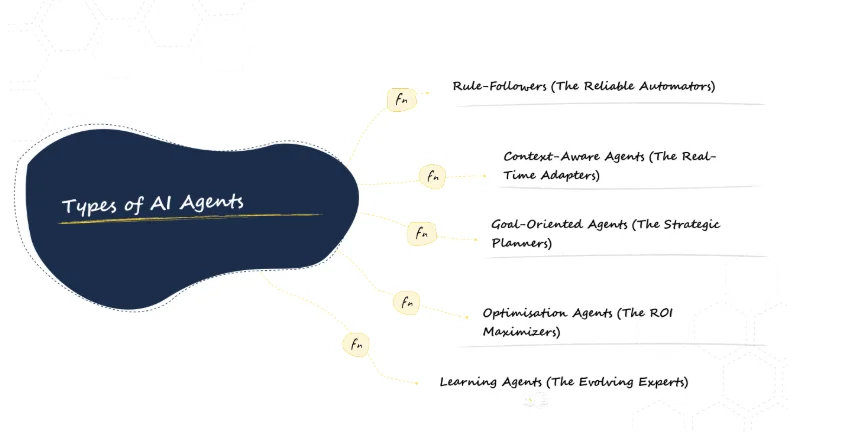
AI agents come in different “styles,” each designed to solve problems in a specific way. But instead of focusing on technical definitions, it’s more helpful to think about how each type contributes to real business workflows.
Here’s a practical breakdown:
Rule-Followers (The Reliable Automators)
These agents operate based on if-this-then-that logic. They’re perfect for environments with clear rules and predictable inputs.
- Use Case: Automatically email confirmation when a customer submits a support ticket.
- Best For: Simple, repeatable tasks where precision and speed matter more than adaptability.
Context-Aware Agents (The Real-Time Adapters)
These agents don’t just react — they consider the situation before acting. They use an internal model of the environment to make more informed decisions.
- Use Case: Monitoring inventory levels and automatically adjusting supply orders based on seasonal demand patterns.
- Best For: Dynamic environments where decisions must adapt to changes quickly.
Goal-Oriented Agents (The Strategic Planners)
Objectives drive these agents. They weigh different paths, evaluate possible outcomes, and choose the one that best achieves a defined goal.
- Use Case: Planning delivery routes for logistics companies, factoring in time, cost, and fuel usage.
- Best For: Scenarios that require decision-making with many variables.
Optimisation Agents (The ROI Maximizers)
These agents don’t just meet goals — they aim to get the most value from every decision. They use utility functions to calculate the best possible outcome.
- Use Case: Choosing between marketing campaigns based on customer engagement, cost, and predicted ROI.
- Best For: High-stakes decisions where trade-offs need to be calculated.
Learning Agents (The Evolving Experts)
These agents get smarter over time. They learn from data, feedback, and experience — improving their performance the more they’re used.
- Use Case: Chatbots that improve their accuracy and tone by analyzing previous customer interactions.
- Best For: Customer-facing roles or processes that benefit from continuous learning and personalization.
AI agents rely on structured workflows to function effectively. These workflows consist of several core components that enable agents to analyze data, make decisions, and execute tasks seamlessly.
Core Components of AI Agentic Workflows
AI agent workflows don’t work in isolation — they rely on several key components to function seamlessly. These components work together to ensure tasks are completed efficiently, decisions are made intelligently, and outcomes are continuously improved. Here’s a breakdown of the essentials:
1. Task Decomposition (Breaking Down the Big Jobs)
For AI agents to work efficiently, they must break down complex tasks into smaller, more manageable subtasks. Task decomposition allows agents to focus on one thing at a time while considering the bigger picture.
- Use Case: An AI agent handling an employee onboarding process might divide it into document submission, training completion, and system access. It would then automatically complete each stage, step by step.
- Why It Matters: By simplifying tasks, AI agents can execute them more accurately and quickly.
2. Decision-Making Processes (Making Smart Choices)
AI agents rely on decision-making frameworks that help them choose the best action based on real-time data. Whether selecting the best supplier or responding to a customer query, these agents weigh options and make decisions quickly.
- Use Case: A delivery AI agent decides the best route based on live traffic data, weather conditions, and delivery urgency.
- Why It Matters: Fast, accurate decision-making lets businesses stay agile and responsive, particularly in environments that require constant adjustments.
3. Interaction with Human Operators (Balancing Human and AI Power)
While AI agents are designed to work autonomously, they still need human input to ensure alignment with business values and ethics. Human operators can step in to provide guidance, approve decisions, or make adjustments to avoid bias.
- Use Case: An AI agent working in HR that flags candidates for bias but requires human review before final selection.
- Why It Matters: Maintaining human oversight ensures that AI decisions align with company values and helps reduce the risk of biases.
4. Integration with Existing Systems (Making AI Part of Your Ecosystem)
AI agents are only as good as their ability to integrate with your current software systems. Whether it’s syncing with CRM platforms, email marketing tools, or document management systems, seamless integration allows AI workflows to enhance existing processes.
- Use Case: An AI agent integrated with your customer relationship management (CRM) system that pulls in customer data, personalizes responses, and updates the CRM automatically.
- Why It Matters: Smooth integration ensures that AI doesn’t work in a silo but complements the tools and processes your teams are already using.
5. Task Completion and Follow-Ups (Ensuring Results and Continuous Improvement)
Once an AI agent completes its task, it measures performance and logs results. This feedback loop helps the agent refine its approach over time, becoming more effective with each cycle.
- Use Case: After a customer service agent resolves a query, it checks customer satisfaction and adjusts its responses for future interactions.
- Why It Matters: Continuous improvement helps the AI improve over time, leading to more efficient operations and better customer experiences.
With a solid technological foundation, AI agentic workflows offer significant benefits, ranging from increased efficiency to enhanced decision-making capabilities. Let’s explore some practical applications across various sectors.
Sample Use Cases Across Industries
Here are some sample use cases of AI agentic workflows across various industries, highlighting their transformative potential:
1. Customer Service Automation
Many companies are deploying AI-powered chatbots to handle customer inquiries, resolve issues, and provide instant support. These agents can manage everything from simple FAQs to complex troubleshooting, escalating only the most critical cases to human agents.
Example: American Express uses AI chatbots to manage customer inquiries, from billing questions to transaction disputes. These bots learn from each interaction, improving over time and enhancing the customer experience.
2. Supply Chain Optimization
AI agents are helping businesses optimize logistics by analyzing real-time data to adjust delivery routes, manage inventory levels, and predict demand. This results in cost savings and better service.
Example: DHL employs AI agents to monitor traffic conditions, weather, and customer demand, dynamically adjusting delivery routes to minimize delays and reduce shipping costs.
3. Financial Fraud Detection
AI agents are transforming the way financial institutions detect and prevent fraud. By analyzing transaction patterns and user behavior in real time, AI agents can flag suspicious activities and even prevent fraudulent transactions before they occur.
Example: PayPal uses AI agents to monitor transactions for signs of fraud, analyze patterns, and flag suspicious activity before it can cause damage.
4. Personalized Marketing Campaigns
AI agents are enabling businesses to deliver hyper-targeted, personalized marketing content based on customer behavior, preferences, and past interactions. This helps companies to improve engagement and boost sales.
Example: Netflix uses AI-powered workflows to recommend personalized content to users based on their viewing habits. This data also creates tailored marketing campaigns that resonate with individual users.
5. Automated Recruitment
AI agents are streamlining the hiring process by automating resume screening, initial candidate assessments, and interview scheduling. They help businesses save time, reduce bias, and improve hiring efficiency.
Example: Unilever leverages AI agents in its recruitment process to scan resumes, analyze social media profiles, and select candidates based on specific criteria. The AI also automates interview scheduling and handles common applicant inquiries.
Challenges in Implementation
Implementing AI agentic workflows presents several challenges organizations must overcome to integrate these systems into their operations. Here are the key challenges identified:
1. Technical Infrastructure Requirements
AI agentic workflows necessitate robust infrastructure, including high computational power and data processing capabilities. Organizations often face high costs when upgrading existing systems or investing in new technologies.
To optimize costs, businesses can leverage cloud-based AI solutions instead of expensive on-premise hardware. Nudgebee’s AI-driven CloudOps Agent enhances operational productivity by efficiently managing cloud resources, reducing the need for extensive infrastructure investments.
2. Data Quality and Availability
The effectiveness of AI workflows relies on structured, high-quality data. Issues like data silos make it difficult to access complete and unbiased datasets, leading to compromised AI outcomes.
Organizations should implement data governance frameworks and real-time monitoring tools. Nudgebee’s AI agents help streamline data collection and standardization, ensuring reliable datasets for AI-driven decision-making.
3. Integration with Legacy Systems
Many businesses operate on legacy systems that are incompatible with modern AI technologies, leading to complex and costly integration processes.
Middleware solutions and API-driven integrations can bridge the gap between legacy and AI systems. Nudgebee’s FinOps Agent ensures cost-efficient integration by automating financial and operational processes, reducing manual intervention.
4. Complexity of Implementation
AI agentic workflows require precise alignment with existing operations, often resulting in compatibility issues and operational disruptions during the transition.
A phased implementation approach minimizes disruption. Nudgebee’s Troubleshooting Agent assists IT teams in identifying and resolving implementation bottlenecks, ensuring smoother adoption.
5. Skills Gap and Expertise
A notable shortage of AI professionals skilled in machine learning, data science, and process automation is slowing down AI adoption.
Companies should invest in upskilling programs and AI-driven automation. Nudgebee’s AI assistants reduce dependency on specialized expertise by handling repetitive tasks and guiding teams through AI workflows.
6. Transparency and Explainability
AI systems are often perceived as “black boxes,” making it difficult to understand decision-making processes, leading to mistrust and compliance challenges.
Implementing explainable AI models and interactive dashboards enhances transparency. Nudgebee provides AI-driven insights that explain actions and recommend improvements, fostering stakeholder trust.
7. Employee Resistance
Employees may resist AI adoption due to fears of job displacement or a lack of familiarity with new technologies.
A strong change management strategy, including training and role enhancement, can mitigate resistance. Nudgebee’s AI agents assist employees by automating repetitive tasks, enabling them to focus on higher-value work instead of being replaced.
Despite their advantages, AI agentic workflows come with challenges that organizations must address to ensure successful deployment. Let’s examine some of the key obstacles and considerations.
Steps for Successfully Implementing AI Agentic Workflows
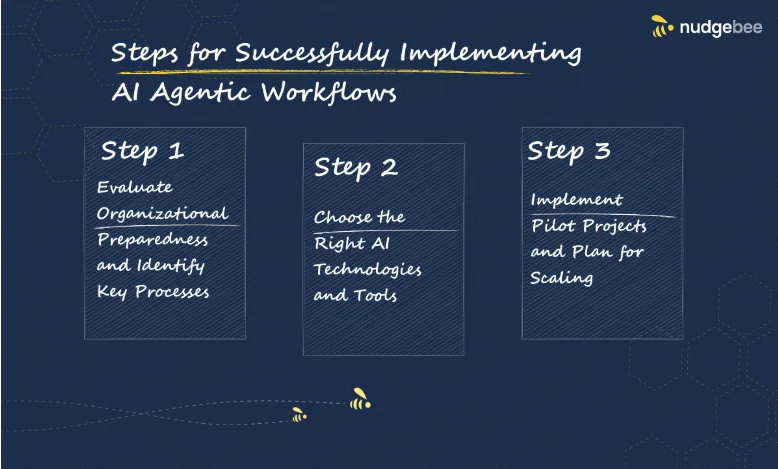
To successfully implement AI agentic workflows, organizations can follow a structured approach that encompasses several key steps. Here’s a comprehensive guide:
Step 1: Evaluate Organizational Preparedness and Identify Key Processes
Before implementing AI, it is crucial to assess the organization’s readiness for integration. This involves evaluating the existing technological infrastructure, financial resources, and workforce skills.
- Readiness Assessment: Determine if the organization has the necessary infrastructure and budget to support AI initiatives. Engage with stakeholders to understand their perspectives on AI adoption.
- Process Identification: Identify processes that are prime candidates for automation. Focus on those that are repetitive, data-intensive, or prone to human error. This targeted approach ensures that the initial implementations yield significant benefits.
Step 2: Choose the Right AI Technologies and Tools
Once suitable processes are identified, the next step is selecting the appropriate AI technologies that align with organizational goals.
- Define Objectives: Clearly outline what you aim to achieve with AI workflows, such as enhancing efficiency or improving customer service.
- Technology Evaluation: Research and evaluate various AI tools and platforms that can address your specific needs. Consider factors such as ease of integration, scalability, and user-friendliness.
Step 3: Implement Pilot Projects and Plan for Scaling
Before rolling out AI workflows across the organization, conducting pilot projects is essential for testing and refinement.
- Pilot Deployment: Implement the AI workflow on a small scale to assess its effectiveness in real-world scenarios. This allows you to identify potential issues without risking widespread disruption.
- Feedback and Iteration: Gather feedback from users involved in the pilot project. Analyze performance metrics to identify areas for improvement and make necessary adjustments.
- Scaling Strategy: Once the pilot proves successful, develop a comprehensive plan for scaling the implementation across other departments or processes. Ensure that lessons learned during the pilot phase inform this broader rollout.
While AI agentic workflows offer a structured approach to automation across industries, the real impact is seen in platforms that harness this technology effectively.
Optimizing AI Agent Workflows with NudgeBee
NudgeBee leverages AI-powered agents to enhance business communication, automate workflows, and drive intelligent decision-making. It provides a robust solution for AI agent workflows, particularly in cloud operations and DevOps environments.
Key Benefits of Nudgebee:
- Streamlined Automation: Using pre-trained models, automating day-2 Kubernetes (k8s) operations, reducing issue resolution time from hours to minutes.
- Human-in-the-Loop Reviews: Ensures human oversight for critical decisions, balancing automation with expert validation.
- Enhanced Troubleshooting: Identifies and resolves Kubernetes issues (e.g., OOMKilled, ImagePullBackOff) while optimizing configurations.
- Seamless Integration: Connects with existing tools like code repositories and ticketing systems for a unified workflow.
- Extensibility & Customization: Modular design allows organizations to add specialized agents and tools as needed.
- Knowledge Graph Insights: A semantic layer connects operational data, improving visibility and decision-making.
Conclusion
AI agentic workflows can revolutionize business operations by enhancing efficiency, automating complex tasks, and enabling smarter decision-making. As these workflows evolve, businesses must prioritize ethical considerations, ensuring fairness and transparency in AI systems.
Moving forward, organizations must foster continuous improvement by refining AI models and staying adaptable to emerging technologies, unlocking further potential for growth and innovation in an increasingly digital world.
Take the first step towards intelligent automation. Signup Now!


